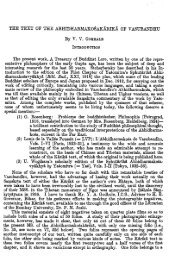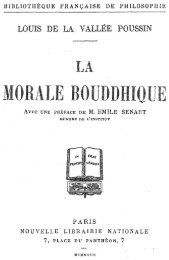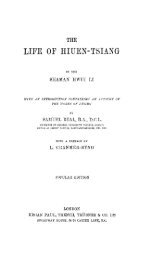La Vallée Poussin Musīla and Nārada. The Path - Gampo Abbey
La Vallée Poussin Musīla and Nārada. The Path - Gampo Abbey
La Vallée Poussin Musīla and Nārada. The Path - Gampo Abbey
Create successful ePaper yourself
Turn your PDF publications into a flip-book with our unique Google optimized e-Paper software.
Musıla <strong>and</strong> N›rada. <strong>The</strong> <strong>Path</strong> of Nirv›˚a: by Louis de <strong>La</strong> <strong>Vallée</strong> <strong>Poussin</strong><br />
22<br />
5) “Of all the conditioned <strong>and</strong> unconditioned factors that there are, cessation, nirv›˚a is the<br />
highest (agra)”; 43 <strong>and</strong> also,<br />
6) “Form (rÒpa) is impermanent; through the cessation of form, there is nirv›˚a, which is<br />
permanent”, <strong>and</strong> the same for the other aggregates (sk<strong>and</strong>ha); <strong>and</strong> also,<br />
7) “It is necessary to actualize nirv›˚a” 44 if it is a non-existent factor (dharma), what factor is<br />
to be actualized?; <strong>and</strong> also,<br />
8) in the Bahudh›tuka: 45 “<strong>The</strong> wise discern conditioned factors <strong>and</strong> unconditioned factors in<br />
accordance with truth”. <strong>The</strong> latter is nirv›˚a: how can you call non-existent that which is<br />
discerned by a ‘cognition that is in accordance with truth’ (yath›bhÒtajñ›na)?;<br />
9) in the sÒtra, there is no [text] that says decisively that nirv›˚a is a non-existent factor<br />
(dharma).<br />
<strong>The</strong>refore, it is [only based on] your own opinions that you state there is no nirv›˚a.<br />
[Answer:] – No:<br />
1) if, independently of the aggregates (sk<strong>and</strong>ha), there is a separate factor (dharma) called<br />
nirv›˚a, you should not give the name of nirv›˚a to the destruction or cessation of the<br />
aggregates;<br />
2) if there is a nirv›˚a, you should tell us its nature (Ch.: t’i), what it is;<br />
3) the concentration (sam›dhi) concerned with nirv›˚a is called ‘signlessness’ (›nimitta). If<br />
the sign of a factor (dharma) exists in nirv›˚a, why give it the name ‘signlessness’? As is<br />
said in the sÒtra: “<strong>The</strong> practitioners view the ab<strong>and</strong>onment of the sign of visible form…,<br />
of the sign of the factors ” (rÒpa…, dharma nimittaprah›˚a);<br />
4) in several places of Scripture, we read: “All the conditioned forces (sa˙sk›ra) are<br />
impermanent, all the factors (dharma) are nonself; nirv›˚a is peaceful”. By ‘self’ should<br />
be understood the intrinsic nature of factors (Ch.: t’i-sing; svabh›va). ‘Not viewing the<br />
intrinsic nature of factors’ is what is called: ‘Viewing the nonself’. If nirv›˚a is a factor<br />
(dharma), then it is impossible to view [the nonself or] the absence-of-intrinsic-nature [in<br />
it], since this factor [that is nirv›˚a] does not perish. [For example,] as long as the pitcher<br />
exists, for that long there is no factor-of-passing-away of the pitcher (gha˛avyayadharma,<br />
gha˛avibhava-): when the pitcher passes away, then we can speak of its passing away; the<br />
same applies for the tree that is cut down; likewise, while the conditioned forces<br />
43 Aºguttara, II, 34. – “Documents”, p. 53.<br />
44 Sa˙yutta, V, 251.<br />
45 Majjhima, III, 63.






